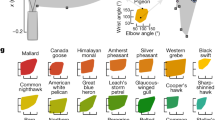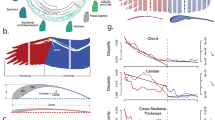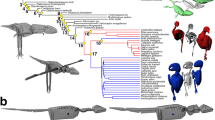Abstract
Despite recent advances in aerodynamic1,2, neuromuscular3,4,5 and kinematic6,7 aspects of avian flight and dozens of relevant fossil discoveries8, the origin of aerial locomotion and the transition from limbs to wings continue to be debated9,10. Interpreting this transition depends on understanding the mechanical interplay of forces in living birds, particularly at the shoulder where most wing motion takes place. Shoulder function depends on a balance of forces from muscles, ligaments and articular cartilages, as well as inertial, gravitational and aerodynamic loads on the wing11. Here we show that the force balance system of the shoulder evolved from a primarily muscular mechanism to one in which the acrocoracohumeral ligament has a critical role. Features of the shoulder of Mesozoic birds and closely related theropod dinosaurs indicate that the evolution of flight preceded the acquisition of the ligament-based force balance system and that some basal birds are intermediate in shoulder morphology.
This is a preview of subscription content, access via your institution
Access options
Subscribe to this journal
Receive 51 print issues and online access
$199.00 per year
only $3.90 per issue
Buy this article
- Purchase on Springer Link
- Instant access to full article PDF
Prices may be subject to local taxes which are calculated during checkout



Similar content being viewed by others
References
Hedrick, T. L., Usherwood, J. R. & Biewener, A. A. Wing inertia and whole-body accelerations: an analysis of instantaneous aerodynamic force production in cockatiels (Numphicus hollandicus) flying across a range of speeds. J. Exp. Biol. 207, 1689–1702 (2004)
Spedding, G. R., Rosén, M. & Hedenström, A. R. A family of vortex wakes generated by a thrush nightingale in free flight in a wind tunnel over its entire natural range of flight speeds. J. Exp. Biol. 206, 2313–2344 (2003)
Biewener, A. A. & Dial, K. P. In vivo strain in the humerus of pigeons (Columba livia) during flight. J. Morphol. 255, 61–75 (1995)
Jenkins, F. A., Dial, K. P. & Goslow, G. E. J. A cineradiographic analysis of bird flight: the wishbone in starlings is a spring. Science 241, 1495–1498 (1988)
Goslow, G. E. J., Wilson, D. & Poore, S. O. Neuromuscular correlates to the evolution of flapping flight in birds. Brain Behav. Evol. 55, 85–99 (2000)
Tobalske, B. W. Neuromuscular control and kinematics of intermittent flight in the European starling (Sturnus vulgaris). J. Exp. Biol. 198, 1259–1273 (1995)
Tobalske, B. W., Peacock, W. L. & Dial, K. P. Kinematics of flap-bounding flight in the zebra finch over a wide range of speeds. J. Exp. Biol. 202, 1725–1739 (1999)
Chiappe, L. M. & Witmer, L. M. Mesozoic Birds (Univ. California Press, Berkeley, 2002)
Dial, K. P. Wing-assisted incline running and the evolution of flight. Science 299, 402–404 (2003)
Xu, X. et al. Four-winged dinosaur from China. Nature 421, 335–340 (2003)
Gatesy, S. M. & Baier, D. B. The origin of the avian flight stroke: a kinematic and kinetic perspective. Paleobiology 31, 382–399 (2005)
Gray, S. J. Animal Locomotion. (Weidenfeld and Nicolson, London, 1968)
Pennycuick, C. J. The strength of the pigeon's wing bones in relation to their function. J. Exp. Biol. 46, 219–233 (1967)
Jenkins, F. A. The evolution of the avian shoulder joint. Am. J. Sci. 293, 253–267 (1993)
Poore, S. O., Sánchez-Haiman, A. & Goslow, G. E. J. Wing upstroke and the evolution of flapping flight. Nature 387, 798–802 (1997)
Sy, M. Funktionell-anatomische untersuchungen am vogelflügel. J. Ornithol. 84, 199–296 (1936)
Bannasch, R. Morphologisch-funktionelle untersuchung am lokomotionsapparat der pinguine als grundlage fur ein allgemeines bewegungsmodell des unterwasserfluges. Gegenbaurs Morphol. Jahrb. 132, 757–817 (1986)
Usherwood, J. R., Hedrick, T. L., McGowan, C. P. & Biewener, A. A. Dynamic pressure maps for wings and tails of pigeons in slow, flapping flight, and their energetic implications. J. Exp. Biol. 208, 355–369 (2005)
Jenkins, F. A. & Goslow, G. E. J. The functional anatomy of the shoulder of the Savannah monitor lizard (Varanus exanthematicus). J. Morphol. 175, 195–216 (1983)
Ostrom, J. H. Some hypothetical stages in the evolution of avian flight. Smithson. Contrib. Paleobiol. 27, 1–21 (1976)
Zhou, Z. & Zhang, F. A long-tailed, seed-eating bird from the Early Cretaceous of China. Nature 418, 405–409 (2002)
Zhou, Z. & Zhang, F. Anatomy of the primitive bird Sapeornis chaoyangensis from the early cretaceous of Liaoning, China. Can. J. Earth Sci. 40, 731–747 (2003)
Norell, M. A. & Clarke, J. A. Fossil that fills a critical gap in avian evolution. Nature 409, 181–184 (2001)
Dial, K. P. & Biewener, A. A. Pectoralis muscle force and power output during different modes of flight in pigeons (Columba livia). J. Exp. Biol. 176, 31–54 (1993)
Poore, S. O., Ashcroft, A., Sánchez-Haiman, A. & Goslow, G. E. J. The contractile properties of the M. supracoracoideus in the pigeon and starling: a case for long-axis rotation of the humerus. J. Exp. Biol. 200, 2987–3002 (1997)
Woolley, J. D. The functional morphology of the avian flight muscle M. coracobrachialis posterior. J. Exp. Biol. 203, 1767–1776 (2000)
Gatesy, S. M., Dial, K. P. & Jenkins, F. A. An inside look at skeletal motion in flying birds. J. Vert. Paleo. 24, 63A (2004)
De Beer, G. Archaeopteryx lithographica: A Study Based upon the British Museum Specimen (The Trustees of the British Museum, London, 1954)
Paul, G. S. Dinosaurs of the Air (The Johns Hopkins University Press, Baltimore, 2002)
Chiappe, L. M., Ji, S., Ji, Q. & Norell, M. A. Anatomy and systematics of the Confuciousornithidae (Theropoda: Aves) from the Late Mesozoic of Northeastern China. Bull. Am. Mus. Nat. Hist. 242, 1–89 (1999)
Acknowledgements
We are grateful to K. Dial for the pigeon specimen, K. Middleton for help with VTK, C. Sullivan and L. Claessens for sharing alligator video and specimens, Z. Zhou for access to fossils at IVPP, T. Roberts for methodological advice, and the Brown Morphology group. We thank Autodesk for Maya software support and the SHAPE lab at Brown University for access to 3D laser scanning equipment. Funding was provided by the National Science Foundation (S.M.G., SHAPE lab), a Bushnell Faculty Research Grant (S.M.G.), the Paleontological Society (D.B.B.) and Sigma Xi (D.B.B.).
Author information
Authors and Affiliations
Corresponding author
Ethics declarations
Competing interests
Reprints and permissions information is available at www.nature.com/reprints. The authors declare no competing financial interests.
Rights and permissions
About this article
Cite this article
Baier, D., Gatesy, S. & Jenkins, F. A critical ligamentous mechanism in the evolution of avian flight. Nature 445, 307–310 (2007). https://doi.org/10.1038/nature05435
Received:
Accepted:
Published:
Issue Date:
DOI: https://doi.org/10.1038/nature05435
This article is cited by
-
Origin of the propatagium in non-avian dinosaurs
Zoological Letters (2023)
-
The locomotory apparatus and paraxial swimming in fossil and living marine reptiles: comparing Nothosauroidea, Plesiosauria, and Chelonioidea
PalZ (2021)
-
Archaeopteryx feather sheaths reveal sequential center-out flight-related molting strategy
Communications Biology (2020)
-
Evolution of the vertebrate skeleton: morphology, embryology, and development
Zoological Letters (2015)
-
The evolutionary continuum of limb function from early theropods to birds
Naturwissenschaften (2009)
Comments
By submitting a comment you agree to abide by our Terms and Community Guidelines. If you find something abusive or that does not comply with our terms or guidelines please flag it as inappropriate.



